| Pages:
1
2
3
4 |
jdowning
Oud Junkie
    
Posts: 3485
Registered: 8-2-2006
Location: Ontario, Canada
Member Is Offline
Mood: No Mood
|
|
It is worth mentioning here in the context of pitch standards that the international standard pitch of A440 Hertz (i.e a') is relatively modern -
established in 1939 - after several attempts at creating a universal standard made by countries like France, Britain and America during the 19th C.
Until then it was pretty much chaos for the travelling musician and instrument maker with every country, province, city, town, church or opera house
having their own preferred 'standard' over the centuries. Military bands preferred a higher pitch because it sounded better out doors, opera houses
and churches preferred a lower pitch to avoid 'screeching' sopranos but not so low as to inconvenience the basses etc.
Pitch standards over the centuries - determined from old tuning forks, pitch pipes and organ pipes or calculated from data provided in theoretical
works - ranged from a low a' of A373.1 Hz to a high of A567.3 Hz (source A.J.Ellis - translator of 'On the Sensations of Tone' by Hermann
Helmholtz).
The pitch of A415 adopted in recent times (1960's?) by the early music fraternity as supposedly representing the pitch of Baroque period instruments
has no historical basis. It is just a convenient full semi tone lower than the reference pitch A440. The same applies to A392 which is a full tone
lower.
It would seem from earlier comments that early middle eastern musicians may have (and still do) instinctively tune to a pitch approximately a semitone
to a full tone below A440 (presumably without any reference to a pitch standard tuning fork) just because an oud or other instrument happen to sound
and feel 'right' at a lower pitch. Something to do with the peculiar sensitivity of human hearing to being receptive to a particular middle range of
frequencies perhaps?
|
|
|
jdowning
Oud Junkie
    
Posts: 3485
Registered: 8-2-2006
Location: Ontario, Canada
Member Is Offline
Mood: No Mood
|
|
I have just found out that the international standard of A440 proposed in 1939 was only affirmed as an international standard in 1955 by the
International Organisation for Standardisation. So that pitch standard, officially, is of even more recent history!
Forum member al-Halibi in the past topic 'Safi al Din 'Abd al-Mu'min aka: Kitab al-adwar" mentions that at the first Congress of Arab Music held in
Cairo in 1932 it was decided that the note 'Rast' would be standardised as C (I assume that is c' or middle C (261.63 Hz) in Western nomenclature?)
and that the Turks standardised the standard pitch in the modern period with the second open string of the oud (neva) equal to A220 Hz (i.e. a) which
is in line with the Western standard.
|
|
|
jdowning
Oud Junkie
    
Posts: 3485
Registered: 8-2-2006
Location: Ontario, Canada
Member Is Offline
Mood: No Mood
|
|
The traditional Turkish oud tuning as I understand it is E A B e a d' for a traditional string length of 58.5 cm? This tuning would have been used
prior to the availability of modern nylon strings so would have once have been used when the Turkish oud - like the Arabic oud - was gut strung.
For a gut strung Turkish oud of 58.5 cm string length the highest pitch that the first course can be taken to without problems of frequent string
breakage is f X L = 210 - regardless of string diameter. So with L equal to 0.585 metre, maximum pitch would be about 210/0.585 = 359 Hz or about f'#
at A440 standard (or a semitone below g' at A440 ).
So why is the Turkish oud not tuned to a nominal relatively high tuning of F B c f b g' as well as the lower pitch tuning E A B e a d' similar in
concept to the longer string length Arabic oud which has a high pitch tuning of F A d g c' f' as well as the lower pitch tuning of C F A d g c'?
Could it be that this high pitch tuning was at one time in use for the Turkish oud - a tuning now long since forgotten? If so the instrument could
have been entirely strung in plain gut/silk in the days when only plain gut and plain silk strings were the option - i.e. using high twist plain gut
for the basses? A plain silk first course could have been tuned a bit higher than gut to g'.
Today, of course, with nylon strings and wound basses both high or low pitch tunings would not be a problem.
Also, if Arabic oud players instinctively tune to about a semi tone or tone lower than A440 standard pitch does this phenomenon also apply to Turkish
oud players?
|
|
|
jdowning
Oud Junkie
    
Posts: 3485
Registered: 8-2-2006
Location: Ontario, Canada
Member Is Offline
Mood: No Mood
|
|
This thread was started with the intent to discuss some basic tools and methods available for string calculations - for plain strings as well as wound
- to assist those who are generally unfamiliar with string technology and are not rocket scientists.
As the discussion about tuning systems etc. now seems to have fizzled out, this might be an appropriate time to talk about the available tools for
string calculations.
Those handy with a pocket calculator can always work from first principles by applying the Mersenne-Taylor law for plain, cylindrical vibrating
strings but others have developed calculators that make this step unnecessary. The following calculators have been designed for lute string
calculations that will also generally apply to the oud except that for the oud the lower range limit of plain strings may be extended somewhat due to
the use of a risha (rather than soft fingertips) to pluck the strings.
First there is the free on line calculator developed by Arto Wikla for plain string (not wound string) calculations handy for providing string
tensions for particular string diameters (and vice versa) given known string length, pitch and string density.
JavaScript (free) must be enabled to view the calculator.
http://www.cs.helsinki.fi/u/wikla/mus/NewScalc
Northern Renaissance Instruments (N.R.I.) have developed a slide rule calculator that may be purchased (high resolution hard copy) for a nominal sum
or downloaded free at :
http://www.nrinstruments.demon.co.uk/StrCalc.html
This slide rule supercedes an earlier version that was originally published in FoMRHI (Fellowship of Makers and Researchers of Historical Instruments)
Quarterly 013, Comm. 162. I attach a copy here for those who who would like to print it up and make the slide rule by gluing the scales to a thick
card, wooden or plastic backing. The attached image shows my version of the slide rule made up, ready for use. The two elastic bands are a rough and
ready way to keep everything in place.
The advantage of a slide rule is that it enables many options of tension, diameter, string length etc. to be compared at a glance.
The low cost commercial slide rule available from Pyramid strings covers plain strings in gut, nylon and PVF as well as their range of wound lute
strings and the range limits of the plain strings.
(Bernd Kürschner once produced a similar slide rule but this apparently is no longer currently available).
A very comprehensive string calculator has been developed by lutenist Paul Beier that does the plain string calculations and includes wound string
data from Savarez, Pyramid, Kürschner and Aquila string catalogues. This software is shareware but is free to download and test at:
http://www.musico.it/lute_software/bsfc/index.html
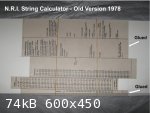


Attachment: NRI String Calculator Old Version.reduced pdf.pdf (368kB)
This file has been downloaded 324 times
|
|
|
Aymara
Oud Junkie
    
Posts: 1162
Registered: 10-14-2009
Location: Germany / Ruhr Region
Member Is Offline
Mood: No Mood
|
|
Hi J.D.!
Quote: Originally posted by jdowning  | | It is worth mentioning here in the context of pitch standards that the international standard pitch of A440 Hertz (i.e a') is relatively modern ...
|
... and was often critized by experts (composers and musicians).
This is an interesteing topic. So let me mention the so called "natural standard pitch" of C in 256 Hz / A in 432
Hz, also called the Verdi pitch.
Did you ever do a research on this pitch and it's theory? If not, THIS might be a good start.
It might also be worth mentioning, that medical tuning forks are based on this pitch, mainly tuned in 128 & 256 Hz.
I'm asking myself, if this might be related to the original question regarding old tone wood / old ouds.
What do the others think? Especially you J.D. and also Master Faruk.
Am I on the wrong track with my thoughts? The 8 Hz difference is much less, than what was discussed before. But maybe it's worth to try it out.
Greetings from Germany
Chris
|
|
|
jdowning
Oud Junkie
    
Posts: 3485
Registered: 8-2-2006
Location: Ontario, Canada
Member Is Offline
Mood: No Mood
|
|
Thanks for the link Aymara - I look forward to reading the article when I get a moment.
Some connection with earlier beliefs in Celestial harmony or 'Music of the Spheres' perhaps? - once supported by some of the greatest scientific minds
in history but now dismissed as a pseudoscience by modern scientists in their infinite wisdom (too much magic and mystery about it to be trusted or
proven).
During the 19th C pitch standards were still 'all over the place' although certain pitch standards were becoming popular for a variety of reasons. At
one time I had an active interest in restoration of mid 19th C American reed organs and brass wind instruments - working for a local museum. The pitch
often chosen for 19th American keyboard instruments was the so called French or 'Flat' pitch A435 Hz or sometimes the English New Philharmonic Pitch
of A439 Hz.
Brass instruments sound better outdoors at a higher pitch so the 19th C American instruments were often built to the so called 'Sharp' pitch of A452
Hz. Something to watch out for when purchasing original 19th C instruments if the intention is to perform with other modern instruments built to A440
pitch.
A435 is even closer to A432 so perhaps was chosen for similar reasons - because it somehow felt right?
|
|
|
Aymara
Oud Junkie
    
Posts: 1162
Registered: 10-14-2009
Location: Germany / Ruhr Region
Member Is Offline
Mood: No Mood
|
|
Nowadays critics call it "new age nonsense", but it isn't because it has a long history, which shows THIS article for example.
If there wouldn't have been World War II, 440 Hz would never have become standard ... I found german sources proving this theory.
It seems very likely and is a good question, but I think we'll need a lot of research to answer this question correctly. Maybe it was just a
measurement error?
Greetings from Germany
Chris
|
|
|
jdowning
Oud Junkie
    
Posts: 3485
Registered: 8-2-2006
Location: Ontario, Canada
Member Is Offline
Mood: No Mood
|
|
At the '19th C living history' museum where I was once employed, two reed organs were regularly used as accompaniment for singers one pitched at the
French pitch A435 the other at A439. I have to admit that the A435 Hz instrument felt much more comfortable for those of us who were not trained
singers - which, no doubt, is the reason that this standard pitch was adopted by the French in the mid 19th C. However, a much greater influence over
pitch standards was exerted by the military who had adopted a higher pitch and employed many of the instrumentalists at the time. They were therefore
reluctant to change their position to a lower pitch standard not only due to cost considerations but because the sound of a military band instruments
carried further at a higher standard pitch. So presumably this was the main reason for adoption of A440 as a compromise (close enough to the British
Philharmonic standard of A439 as well). Also, from the German Reich viewpoint at the time (1939) the exclusion of the French in the proceedings and
non adoption of their A435 standard would, no doubt, have had some considerable political significance not connected to any musical considerations.
As European military bands were originally developed from the Janissary military bands of the early Ottoman Empire one has to wonder what pitch
standards the Turkish wind instruments were (are still?) made to? I would not be surprised if it was once significantly above A440.
Of course, the original purpose of military bands was to intimide the enemy and not for musical entertainment - loud noise that not only carried far
but was psychologically disturbing. A432 pitch would probably not have been the way to go!
|
|
|
Aymara
Oud Junkie
    
Posts: 1162
Registered: 10-14-2009
Location: Germany / Ruhr Region
Member Is Offline
Mood: No Mood
|
|
Quote: Originally posted by jdowning  |
I have to admit that the A435 Hz instrument felt much more comfortable for those of us who were not trained singers ...
|
I read somewhere, that a famous composer criticized A440 and higher pitches for being difficult even for trained singers.
| Quote: |
Also, from the German Reich viewpoint at the time (1939) the exclusion of the French in the proceedings and non adoption of their A435 standard would,
no doubt, have had some considerable political significance not connected to any musical considerations.
|
Interesting theory! I read that this bastard Goebels was mainly influenced by Wagner regarding A440, but this political thing might have been a
further reason.
| Quote: |
A432 pitch would probably not have been the way to go!
|
Mmh, this military theory is new to me, but it seems to make sense.
Back to the oud ... do we know anything about the "arabic pitch history"?
Greetings from Germany
Chris
|
|
|
jdowning
Oud Junkie
    
Posts: 3485
Registered: 8-2-2006
Location: Ontario, Canada
Member Is Offline
Mood: No Mood
|
|
As previously mentioned in this thread, I suspect that the early ouds - like the European lute - strung as they were in gut or plain silk - tuned the
first course as high as it would go without frequent breakage in order for the lower bass courses to sound well.
The string lengths would likely have been somewhat longer than found today for the same reason - to provide an optimum response from the basses.
My guess (from studies of the early descriptions on the oud as well as examination of the earliest surviving lutes from the early 16th C) is that
string length would have been 67.5 cm or thereabouts. Given this assumption and assuming a plain silk first course (stronger than gut), the upper
tonal limit would have been f' (at A415 Hz standard pitch) according to my Pyramid calculator for a tension of about 34 Newtons or around 3.5 Kg (9.8
Newtons = 1Kg although I usually just divide Newtons by 10 to convert to Kg).
This suggests to me - based upon these physical constraints - that the earliest tuning for a five course oud of the 14th C may have been AA dd gg
c'c' f'f' - all courses then being tuned a fourth apart.
Again A pitch (at A415 Hz standard) would be about the lower tonal limit for a plain gut Bamm (fifth course) string so that all fits quite nicely -
suggesting in turn that the modern (Munir Basher) high Arabic tuning of F A d g c' f' may be a lot more ancient in origin than might at first be
apparent.
|
|
|
Aymara
Oud Junkie
    
Posts: 1162
Registered: 10-14-2009
Location: Germany / Ruhr Region
Member Is Offline
Mood: No Mood
|
|
It might be interesting to research, if this 415Hz assumption is correct.
A question that might help ... how about the Ney? How was it's pitch in history?
Wasn't the Ney played together with oud in history too? If yes, then the oud was tuned to the Ney in ensembles, wasn't it?
And we shouldn't forget, that e.g. in medieval times it wasn't possible to measure the pitch as good as it got possible in 19th C.
So your assumption regarding string brake makes especially sense for solo play, I think.
But what about singers? Might the oud have been tuned to the capabilities of the singers too?
Greetings from Germany
Chris
|
|
|
jdowning
Oud Junkie
    
Posts: 3485
Registered: 8-2-2006
Location: Ontario, Canada
Member Is Offline
Mood: No Mood
|
|
The A415 (a semitone below A440 reference standard pitch) is just for our reference so that we know exactly what frequency we are all talking about.
At this reference standard pitch, the note A (about 104 Hz) of the fifth course is the low pitch limit for a plain, low twist gut string which would
have been much the same for the ancients who, of course, would have had no idea what frequency meant let alone how it might be measured in Hertz.
The physical properties of the strings dictates the maximum possible viable tonal range for a given string length - i.e. string life for the first
course and acceptable dullness of sound for the bass strings.
To avoid any confusion - at A415 standard reference pitch the limiting string pitches for a plain gut strung five course 14th C oud of 67.5 cm string
length might be
f' - 329 Hz
c' - 247 Hz
g - 185 Hz
d - 138 Hz
A - 104 Hz
The thinnest gut string available would have been about 0.40 to 0.45mm giving a tension for the first course of about 3.5 Kg to 4 Kg and for the fifth
course, diameter around 1 mm about 2.5 Kg
|
|
|
Aymara
Oud Junkie
    
Posts: 1162
Registered: 10-14-2009
Location: Germany / Ruhr Region
Member Is Offline
Mood: No Mood
|
|
I tried to find out more about the pitch in arabic history ... nothing so far ... I searched generell, for Oud and Ney ... all I could find was, that
the pitch was based on oral tradition ... I hope that's the right word in English 
And then the question is, about witch aera do we talk. I myself am very interested in Al-Andalus. How about Ziryab's time? Isn't it likely, that the
pitch was lower in that time? Just a guess. And how about the string length ... isn't it likely, that it was shorter at that time.
I think you are the expert in this "business" ... and I'm curious 
| Quote: |
f' - 329 Hz
c' - 247 Hz
g - 185 Hz
d - 138 Hz
A - 104 Hz
|
That makes sense, if our assumptions regarding string length and pitch are correct/close.
Greetings from Germany
Chris
|
|
|
Aymara
Oud Junkie
    
Posts: 1162
Registered: 10-14-2009
Location: Germany / Ruhr Region
Member Is Offline
Mood: No Mood
|
|
... but I found something interesting from Western history. Even nowadays some historic instruments are still tuned to the Versailles pitch A = 392 Hz
as an alternative to 415. I saw that for example on the website of a flute builder, in this case Barock flutes. Even Barock concerts are sometimes
played at that pitch nowadays.
Do you know something about it's "origin"? Might it be even older?
Might similar low tunings have been used in the arabic world?
That would fit to the findings reported about old ouds, doesn't it?
Greetings from Germany
Chris
|
|
|
jdowning
Oud Junkie
    
Posts: 3485
Registered: 8-2-2006
Location: Ontario, Canada
Member Is Offline
Mood: No Mood
|
|
The standard pitch A392 - like A415 - has no particular historical significance either. It is just a full tone below A440 adopted for convenience by
the modern early music fraternity.
For a comprehensive listing of historical pitches, check the Appendix added by Ellis to Hermann Helmholtz's 'On the Sensations of Tone' An English
translation is available free from Internet Archive (Google search)
An abbreviated tabulation can also be found at:
http://www.dolmetsch.com/musictheory27.htm
(as well as a lot of interesting related information).
There is only one example of A392 (actually 392.2) said to be from a clavichord in St Petersburg, Russia, 1739 - so not sure where the 'Versailles'
pitch comes from.
For the early oud - as with any stringed instrument strung in plain gut or silk - the max/min pitch range for a given string length is determined by
the the life of the top string (breaking frequency) and the dullness of sound of the lowest bass string (a subjective judgement). In modern times we
are able to give a maximum and minimum frequency value to this range. In early times no such standard measurement existed to my knowledge - the early
theorists on the fretted oud only referring to tuning intervals for the open strings.
Ziryab (9th C) is said to have introduced a fifth string to the four course oud - but this additional string was placed between the third and second
courses (Mathlath and Mathna) according to G.H. Farmer so I am not sure what the tuning of the open courses might have been. Ziryab is also said to
have introduced silk strings as well as gut to the oud.
Farmer speculates (based upon the tuning of the surviving Tunisian oud arbi) that the tuning of the four course oud was originally c d g a but was
changed to A d g c' (i.e. the open strings tuned a fourth apart, Bamm, Mathlath, Mathna, Zir) when the Arabs adopted the Persian system. The five
course oud according to Al-Kindi added a high first course (Hadd) making the tuning A d g c' f' (in modern nomenclature).
The four course oud might also have been tuned d g c' f' (or somewhere in between the extreme limits of A and f' at A415 modern standard pitch) - for
an assumed string length of 67.5 cm. Shortening the string length to say 60 cm would result in a max/min range for plain gut of about c to g'.
My guess is that the longer string length of 67.5 cm prevailed until wound strings became available to allow further lowering of the bass string tonal
limit.
We have practically no idea about the construction of early oud strings (or for that matter, lute strings) made from gut so it is best to assume that
the earliest strings were simply twisted without being 'weighted' or made of roped construction to improve performance (as proposed by some modern
'historical' string makers). For a plain, simply twisted string, some degree of improved elasticity (and consequent greater bass range) - at the
expense of breaking strength - can be achieved by increasing the degree of twist of the gut fibres.
|
|
|
jdowning
Oud Junkie
    
Posts: 3485
Registered: 8-2-2006
Location: Ontario, Canada
Member Is Offline
Mood: No Mood
|
|
Wound string calculations.
In order to determine the string tension for a given pitch of a wound string - round section wire wound over a flexible core material - it is first
necessary to establish an Equivalent Diameter for the string - as if made only from the core material. This then allows string tensions to be
determined using the Mersenne-Taylor law applicable to plain cylindrical strings of uniform density.
The attached image shows a well established relationship used for close wound string design. Knowing the core diameter, wire diameter and densities of
the core and wire materials the Equivalent Diameter may be determined.
Conversely, for a string of unknown manufacture, the Equivalent Diameter may be determined by accurately measuring the outside diameter and the wire
diameter, knowing the core and wire densities.
For those of us who are not rocket scientists the calculations might seem forbidding but with a low cost ($5 - $10) scientific pocket calculator and a
low cost (but good quality) Chinese micrometer (to accurately measure diameters) it is only a matter of punching in the numbers and letting the
calculator do the work. No need even to understand how to calculate the square or square root of a value - just press the appropriate calculator
button to get the answer.
Furthermore, once having calculated the Equivalent Diameter there is no need to have knowledge of the Mersenne-Taylor law to calculate string
tensions. This has all been done by Arto Wikla - just use his free online calculator.
For information, I have used as an example the third course d string from a set of Pyramid #650 oud Orange label. The Pyramid catalogue gives the
(average) string tension of each third course string as 4.0 Kg (string lengths between 60 cm and 62 cm).
The calculated Equivalent Diameter for a plain nylon string is 1.22 mm diameter. For a string length of 61 cm the Arto Wikla calculator gives a
tension of 3.977 Kg. Pretty close!!
Next to further verify the results using my string test rig.
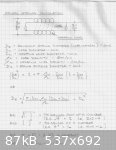
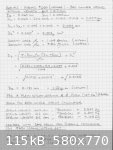

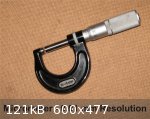
|
|
|
Aymara
Oud Junkie
    
Posts: 1162
Registered: 10-14-2009
Location: Germany / Ruhr Region
Member Is Offline
Mood: No Mood
|
|
Thanks for your detailed explanation.
No need to buy one, if you have a Windows PC. Just use the Windows Calculator and switch to scientific mode in the View menu.
Greetings from Germany
Chris
|
|
|
jdowning
Oud Junkie
    
Posts: 3485
Registered: 8-2-2006
Location: Ontario, Canada
Member Is Offline
Mood: No Mood
|
|
Thanks Chris. A useful alternative.
It is amazing how low in cost basic scientific calculators are now - compared to when they first came on the market in the 1970's costing hundreds of
dollars. Here is what they cost now at a local store. Even when Sales tax is added $3.36 Canadian is a price hard to resist (no - I do not need
another one!).
Lee Valley of Ottawa are selling a Chinese micrometer (Imperial units) that is said to be accurate to 0.0001 inch (0.0025 mm) costing only $18.50
Canadian. The tool does have insulated pads to reduce heat transfer from fingers that will affect accuracy - however, that level of accuracy is
'pushing it' a bit outside of a climate controlled tool/metrology room environment. Still excellent value and quality.
I prefer to work in metric for string dimensions so have a non Chinese micrometer (Starrett #436 )for that purpose inherited from my father. I hate to
think what that might cost these days.

|
|
|
jdowning
Oud Junkie
    
Posts: 3485
Registered: 8-2-2006
Location: Ontario, Canada
Member Is Offline
Mood: No Mood
|
|
For information here are some details of a rig built to aid in the development of historical oud strings made from silk. It will be used here to
verify string tensions of a set of Pyramid #650 orange label oud strings for comparison with calculated values.
The test rig is a simple affair consisting of a sound box on a frame with a fixed bridge at one end and a sliding bridge at the other to allow
adjustment of string length.
String tension is applied directly by means of a suspended load attached to the string passing over a pulley. The rig is mounted at an angle of 45°
in order to minimise friction losses at the pulley that might affect measured string tension (resulting in an overestimate of string tension).
Frequency of vibration for a given string length and load is measured with a low cost digital tuner calibrated with a standard tuning fork.
In operation a load is applied to a string with lead weights and steel washers added for fine adjustment until the required pitch is consistently
measured. The total load is then measured using a digital scale accurate to 1 gram.
Next the test results.

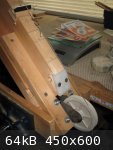

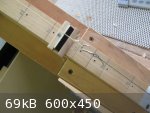
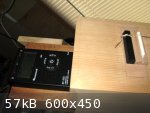
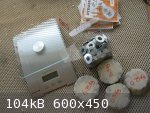
|
|
|
fernandraynaud
Oud Junkie
    
Posts: 1865
Registered: 7-25-2009
Location: San Francisco, California
Member Is Offline
Mood: m'Oudy
|
|
It's very useful to have this method. And at last we'll be able to confirm some of the calculations, and over a wider range!
But these simplified "effective" thickness models rely on the same equations as are used for a homogeneous material, right? So I don't see anything
here any more nor less correct than the very simple working method I use. Can you look and tell me? Let me try to clearly state what is actually quite
obvious.
The question most often asked is: what will be the tension if I tune this specific string to pitch X on scale Y? With a homogeneous material of known
density, say Nylon or PVF, we can plug the material, length, thickness and pitch into Arto's, and get a tension. We can probably agree that Arto's is
a good usable interface to the fundamental equations.
The first problem with wound strings is that density varies with "gauge" or thickness. Your method attempts to derive that, and then express it not as
density, but as an equivalent thickness of the core material. I'm not sure we can assume the core is homogeneous, nor that the winding is always done
the same way, but it seems irrelevant to me how we "virtualize" it. In the end we'll plug it into the same equation.
The non-rocket science way I've been doing it doesn't rely on measuring the winding wire and assuming the packing of the core or winding will be the
same from one string maker to another. It just uses data provided by the string-maker. Like this:
We take the tension listed for the string under consideration at one length, gauge and pitch, and we use Arto's in reverse to hunt for the density
that would give that tension. That is the "effective density" of that composite string. Say 5765 Kg per cubic meter for a 0.033" D'Addario wound
string.
It's likely, though I've never tried it, that if we weighed a known length of a given string, we would come up with a similar density. And if not,
then the "effective density" is more relevant, because it works in the equation.
We know, for sure, that if the maker's tension is accurate, that our "effective density" of the composite wound string works (if nothing else) at that
specific length and pitch in Arto's.
At this step I just do the same thing you do, which is to assume the same equation will apply at different lengths and pitches, within reason of
course, i.e. over a pretty narrow region. It's doubtful if Arto's calculator will give accurate tensions if you stretch the material to near the
breaking point, or if it's very slack.
The advantage of this approach is that it requires no measurements, or extrapolations concerned with windings or core, we just use ONE presumably
correct figure the maker has provided, and we extrapolate it to (slightly) different lengths and pitches.
The disadvantage is that we must have at least one tension figure from the string-maker, which is not always the case, so knowing if your method gives
the expected results on known tension cases is essential.
Make sense?
=================
I would think that by compiling and graphing some effective densities for different maker's wound strings we can interpolate into a chart or nomograph
that would give anyone a ball-park effective density for any given gauge of a "garden variety" silvered copper on nylon fluff wound string. Perhaps we
can derive a correction for specific thickness of winding wire. If this works out, Arto's calculator might incorporate it.
=================
For instance, the "effective densities" of D'Addario wound strings, that I jotted down on one case I was working, were:
DD 0.024" 4540 kg/m^3
AA 0.029" 4890
FF 0.033" 5765
C 0.040" 6225
These might not be exact, they're from scribbled notes. I might have used slightly different gauges, or changed something, but they're in the ball
park. Say on that 0.033" FF course at 600 mm scale, using the 5765 density, we get 3.6 Kg tension.
|
|
|
jdowning
Oud Junkie
    
Posts: 3485
Registered: 8-2-2006
Location: Ontario, Canada
Member Is Offline
Mood: No Mood
|
|
If you already know the manufacturer of a wound string and the code number of a string that is of interest then the best approach would be to simply
ask the manufacturer for information about the tension/pitch relationship for that string for a given string length.
Pyramid once provided tension tables to enable customers to determine these parameters for both their plain and wound strings. I posted these tables
(with the permission of Pyramid) some years ago on this forum. Can't remember when or the title of the topic but a forum search should be productive
for those interested.
The approach of this thread is to determine the tension/pitch relationship of a string (or string fragment even) if the manufacturer is unknown. This
cannot be determined by measurement of the outside diameter of a wound string alone. The previously posted, well established formula - although
approximate - may be used by those brave souls who might be interested in designing and making their own wound strings.
I am using some known strings by Pyramid simply to be able to verify the results of this calculation method.
The design of wound strings compared to plain cylindrical strings (that obey the Mersenne-Taylor law) is complicated by the geometry - smooth
cylindrical core and a 'bumpy' external 'sleeve' as well as the difference in the core and wire densities. So I doubt if your 'equivalent density'
approach will prove to be valid - at least for the design of compound strings.
However - with open mind - once I have completed this part of the thread I shall examine and test some of the Pyramid lute wound strings that I have
in stock to test if your approach is valid even if only approximately.
Concerning establishment of a possible chart or nomograph to compare wound strings between different makers based upon outside diameter measurements -
that might be quite an exercise as the range of wound strings (for lute) from Pyramid alone amounts to over 90 different varieties. However, has this
work in comparing wound string equivalents between some makers not already been done by Paul Beier and his string calculator?
|
|
|
fernandraynaud
Oud Junkie
    
Posts: 1865
Registered: 7-25-2009
Location: San Francisco, California
Member Is Offline
Mood: m'Oudy
|
|
Great! And I in turn eagerly await the results of the "effective thickness" model! Thanks for all your great digging!
|
|
|
fernandraynaud
Oud Junkie
    
Posts: 1865
Registered: 7-25-2009
Location: San Francisco, California
Member Is Offline
Mood: m'Oudy
|
|
I am actually excited by the measurement I just got on a piece of wound string. You may recall that, in order to estimate tension on a wound string of
a given length at a given pitch, I was first deriving an "effective density" for such a wound string based on the tension provided by the manufacturer
and plugging it into the equations used for a homogeneous material.
In other words I was considering the wound string to behave rather like a homogeneous string made of a hypothetical material with that density.
Thus for a 0.024" D'Addario silvered copper on nylon fluff core, I was deriving an effective density of 4,540 kg/m^3. I was suggesting that if we
weighed a length of such string we might well find that its actual density was close to that.
So I measured the weight of a 6 inch length of 0.024" (0.60mm) Daniel Mari wound string, that being ~ 185 mg. The volume was then calculated as a
cylinder's:
(Pi (0.30 mm)^2) (152.4 mm)
and the density worked out to 4309 kg/m^3, compared to the 4540 Kg/m^3 derived effective density on a D'Addario string. YES!!!
That makes sense to me, as a Mari string is a similar wound string, but of a slightly lighter construction than a D'Addario. I'm looking for some
other spare string pieces to weigh, but this is more encouraging even than I expected.
To review, Nylon has a density close to 1040 Kg/m^3, PVF around 1800 and brass around 8600 Kg/m^3. It certainly makes sense that a composite wound
string would have an intermediate density, and as the string gauge increases, the winding gets thicker, and the density of the whole increases.
It should be possible to use the packing geometry and density of the windings and core the way JDowning suggests to calculate a density to use in the
equation, rather than expressing it as an effective thickness of a core material. In the end it seems like a different road to the same approximation.
How are the tension measurements coming?
|
|
|
jdowning
Oud Junkie
    
Posts: 3485
Registered: 8-2-2006
Location: Ontario, Canada
Member Is Offline
Mood: No Mood
|
|
The Arto Wikla calculator is for calculating tensions/diameter based upon the Mersenne-Taylor law where frequency of string vibration is a function of
string length, string tension and the mass per unit length of a string (assuming the mass is uniformly distributed within a string and the string is a
uniform smooth cylinder - neither of which applies to a wound string). Alternatively the frequency of string vibration can be expressed as a function
of string length, string diameter, string density and string tension. If an 'effective density' is to be valid then an associated 'equivalent
diameter' (which is not the measured outside diameter of a wound string) must also be determined in order to use the Mersenne-Taylor law to calculate
string tension for a given string length and frequency of vibration.
For a wound string it is the core that carries the string tension - the purpose of the winding being to add mass without significantly increasing
string stiffness in order to lower frequency of vibration. Provided the core can sustain the required string tension without breaking then there are a
number of possible wire diameter/core diameter combinations (from thick core thin wire to thin core thick wire) all of which will result in the same
measured outside diameter but which will result in different tensions for a given frequency of vibration.
As it is the core that is the structural component of a wound string, string makers design wound strings based upon the 'equivalent diameter' of a
cylindrical smooth string of the same uniform density as the core material according to the relationship previously posted or similar. The final
string performance will then depend upon a number of manufacturing related factors such as tension of the wire during winding causing stretching and
compression of the wire etc.
For information I shall next post how the 'equivalent diameter' formula is derived from first principles by considering the mass per unit string
length contributed by the wire and that of the core.
|
|
|
jdowning
Oud Junkie
    
Posts: 3485
Registered: 8-2-2006
Location: Ontario, Canada
Member Is Offline
Mood: No Mood
|
|
Attached is the derivation of the 'equivalent' wound string formula that enables string tension to be calculated according to the Mersenne-Taylor law
for a uniform smooth cylindrical string of uniform density.
This is the well established basic formula used by string makers (not my idea!) as a preliminary step in the design of close wound strings made of
round wire over a uniform density core.
There are other more complicated variants of the formula aimed at greater precision but the objective here is to test the level of accuracy and hence
usefulness of this basic formula by comparison with some published string data (Pyramid oud string set #650 Orange label) and with data obtained from
load testing strings on a simple test rig.
The most direct information may be obtained from testing a string on the rig as it does not involve any indirect computation.
However, faced with a string fragment of unknown manufacturer - knowing the core and wire diameters and the densities of of the wire and core
materials - the string tension for a given tone frequency may be calculated using the
'equivalent diameter' formula. How accurate? That is what this current investigation is all about.
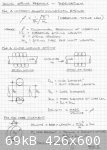
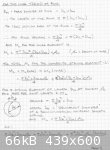
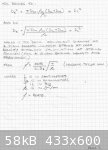
|
|
|
| Pages:
1
2
3
4 |